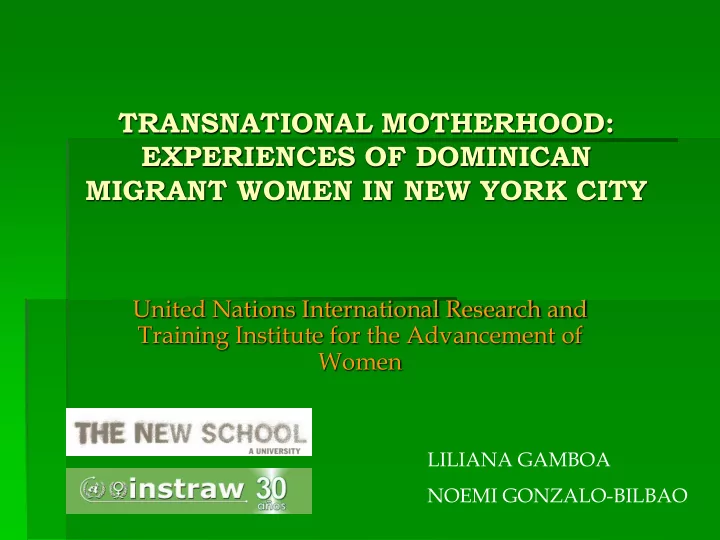

TRANSNATIONAL MOTHERHOOD: EXPERIENCES OF DOMINICAN MIGRANT WOMEN IN NEW YORK CITY United Nations International Research and Training Institute for the Advancement of Women LILIANA GAMBOA NOEMI GONZALO-BILBAO
The International Research and Training Institute for the Advancement of Women (INSTRAW) was created in 1976. Its headquarters are established in the Dominican Republic. Its objectives are: Applied research. Information sharing and dissemination. Capacity building. Institutional development. Transnational Motherhood: Dominican Migrant Women
Project Most immigrants are forced to leave their children back in their countries of origin, creating the so-called transnational families. The purpose of the project is to study the effects of transnational motherhood on Dominican migrant women living in New York City and their experience with family reunification. This research will be part of a larger research that INSTRAW is carrying out in regards to women's migration around the world. It will contribute to expand the knowledge about general migration and more specifically about women's migration. Transnational Motherhood: Dominican Migrant Women
Definition “Transnational motherhood” describes women who work and live in a foreign country while their children live in their country of origin. (Hondagneu-Sotelo, Pierrette and Ernestine Avila. "“I’m Here, but I’m There”: The Meanings of Latina Transnational Motherhood." Gender and Society 11, no. 5 (1997): 548-571.) Transnational Motherhood: Dominican Migrant Women
Need of the Study Lack of research due to an emphasis on the economic aspects of migration (remittances.) Women are not seen as active participants of the migration process. Compare migration patterns of the Dominicans (for example with Dominicans who migrate to Spain.) Transnational Motherhood: Dominican Migrant Women
Project Description Research existing literature. Interview with members of different organizations. Interview Dominican community leaders. Interview Dominican women living in New York City. Document the project via pictures Transnational Motherhood: Dominican Migrant Women
Activity 1 Contact respected people from the community and religious leaders from Washington Heights. Among the different churches are: Pentecostal Church “El Rey Ya Viene.” Presbiterian Church Fort Washington Heights. Methodist Church. Church “San Romero de las Américas.” Evangelic Methodist Church “Efrata.” Transnational Motherhood: Dominican Migrant Women
Activity 2 Contact community associations and local NGOs working within the community. Among them: Alianza dominicana. Northern Manhattan Improvement Center. Latino Commission on Aids. Mujeres en Fe. Dominican Women’s Development Center. Transnational Motherhood: Dominican Migrant Women
Latino Commission on AIDS Transnational Motherhood: Dominican Migrant Women
Activity 3 Get advice from academics: Dominican Studies Institute at CUNY. INSTRAW researchers on migration. Ph.D. Hernandez Director, CUNY-Dominican Studies Institute & Associate Professor of Sociology. Transnational Motherhood: Dominican Migrant Women
Statistics 687,000 foreign-born from the Dominican Republic in the United States. 54% of those are women. 2% of the total foreign-born population in the US. The majority live in the Northeast. 59 % live in New York State. Make up less than one-half of 1% of total US population, but over 2% of New York’s population. ( According to the US Census Bureau in 2000) Transnational Motherhood: Dominican Migrant Women
Statistics Among the lowest average income levels of any racial ethnic groups Annual per capita household income: $11,065. In New York City: $10,032. Poverty rate: 32%. A high proportion of Dominican families in poverty are headed by women, with no spouse present. Educational attainment: among the lowest in the country. 49% of Dominicans 25 years of age or older had not completed high school and only 11% had completed college. Transnational Motherhood: Dominican Migrant Women
Statistics 40% of Dominican population live in Manhattan (Washington Heights), 40% in the Bronx and the rest in Brooklyn (Sunset Park), and Queens (Corona) They formed a Dominican community, where they have their own NGOs, churches and support groups.
Transnational Motherhood: Dominican Migrant Women
Results The women: Most of these mothers come from Dominican urban areas. Higher education level compare to Dominican women who migrate to other countries. Single. Want to remain in the US permanently. Unskilled jobs. Transnational Motherhood: Dominican Migrant Women
Interview Analysis Paternal figure is missing. Children tend to accuse their mothers of abandoning them. Mothers not only have to economically support their kids, they also have to send incentives to those who take care of them back in the DR. Communities disapproval. Transnational Motherhood: Dominican Migrant Women
Interview Analysis Depression and sadness after leaving their children in the Dominican Republic. Economic replacement for the lack of direct care and affection. Exertion of authority from a distance. Frequent contact with their children through mail and phone calls. Transnational Motherhood: Dominican Migrant Women
Conclusions Dominican women in NYC do not experience transnational motherhood as much as other migrant women. Separations and delayed reunifications are traumatic. “It has been 8 years since my kids came to live with me and I feel like crying every time I think about the years we were separated.” (Maria) “When we fight, my kids usually say that I do not know them.” (Marta) Transnational Motherhood: Dominican Migrant Women
Other Findings Dominican women s empowerment. Women leaders among the NY Dominican community, carry out tasks that in the DR are relegated to men (head of the churches, directors of NGOs, politicians, and business owners.) Potential field of study for INSTRAW. Transnational Motherhood: Dominican Migrant Women
Final Comments Refusal to talk about their situations. Focused on their feelings. Time consuming. Community leaders eager to help: “women s efforts had been neglected for a long time.” Difficulty working with organization based outside U.S. Difficulty in getting feedback from a busy UN institute. Transnational Motherhood: Dominican Migrant Women
Recommend
More recommend